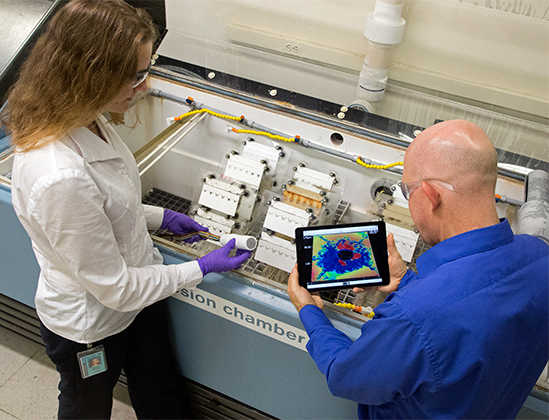Understanding how materials behave in different atmospheric conditions helps manufacturers develop corrosion-resistant alloys, coatings, and finishes. Corrosion scientists at Southwest Research Institute (SwRI) employ a variety of test techniques, outdoor exposure sites, and accelerated corrosion tests to characterize atmospheric corrosion in a state-of-the-art Corrosion Testing Laboratory. More than just a test lab, we are applied R&D experts who help clients worldwide to develop new corrosion mitigation systems, sensors, and testing regimes.
Accelerated Atmospheric Corrosion Test Methods

Chambers used for testing atmospheric testing
No two environments are the same. Even similar environments (e.g., marine and coastal areas) can have different effects on the same materials. This variability presents major challenges with salt fog, salt spray and atmospheric corrosion tests, which have long struggled to replicate failure modes, demonstrate repeatability, and provide meaningful information for life prediction. SwRI addresses these challenges by developing accelerated test methods that are more reliable and representative of real-world conditions. We leverage our vast experience with corrosion sensors and in-situ corrosion rate monitoring to develop a scientific basis for improved accelerated cyclic corrosion tests. Learn more:
Atmospheric Corrosion Sensor R&D
We have been extensively involved with atmospheric corrosion detection sensor design and construction. This work leverages our deep understanding of corrosion processes with the expertise of hardware and firmware designers to develop unique sensing systems. Learn more:
Atmospheric Environmental Assisted Cracking
Structural integrity of aerospace systems, pipelines, spent nuclear fuel storage, and other systems are typically managed using fracture mechanics data acquired under standard laboratory conditions. Evidence suggests, however, that cracking under certain atmospheric conditions can be nearly a factor of 10 higher than those reported in the laboratory. SwRI’s development of an atmospheric control system has shown that cyclic relative humidity plays a major role in crack growth rates. Specifically, as a surface dries, crack growth rates are accelerated significantly. We are actively working to better quantify threshold stress intensity and crack growth rate as a function of differing environmental scenarios for aluminum and stainless alloys.
Related Services
- Corrosion Detection Sensor Research
- Corrosion Testing Laboratory
- Salt Spray Test Services
- Stress Corrosion Cracking
- Sulfide Stress Cracking (SSC) Testing
Or call James Dante at +1 210 522 5458.
